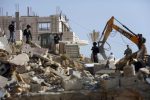At a large plot of land located east of the top of the Mount of Ebal in the northern West Bank city of Nablus stone chains that do not hold any archaeological significance exist yet they are used by Israeli settlers as a self-claimed sacred archaeological site.
Israeli settlers’ attempts to seize the site they claim to be the altar of Joshua Ben Nun reveal how far settlers can go about exploiting myths and using them in their ongoing battle to control Palestinian lands.
The former Israeli Minister of Housing Uri Ariel promised in 2015 to open the site to Jewish settlers to enable them to perform their Talmudic rituals.
Last month settlers sat up a new road of more than two kilometers in the northern town of Asira in order to facilitate their access to the site meaning the seizure of hundreds of dunums of Palestinian land in the area.
Witnesses confirm that settlers organize weekly visits to the site every Saturday.
Archaeologist Dirgham Al-Faris in an interview with the PIC refuted the narrative of Israeli settlers regarding this site pointing out that these claims are a continuation of the Zionist movement’s policy of using religious myths to mobilize Jews around the idea of the Promised Land by linking biblical sites to Jewish religious sanctity.
Facts refute myths
During the 1980s the Israeli archeologist Adam Zeratal carried out archaeological excavations on the site. Through the pottery fragments and two Pharaonic seals found it was revealed that the site dates back to the 13th century BC and claimed to be the altar erected by Joshua Ben Nun.
Al-Faris confirms that the existing architectural remains show that it was a Canaanite altar of idolatry offering sacrifices to the Canaanite Gods.
“In no way can the altar be the resting place of Ben Nun because the assumption that the altar belongs to Joshua Ben Nun contradicts the historical and archaeological facts that prove that Joshua Ben Nun is a myth and not a historical figure” he says.
Al-Faris bases his assumptions on the results of excavations carried out by many archaeologists in Palestine as well as by many internationally recognized archaeologists including Israeli archaeologists most notably Professor Israel Finkelstein who says that Joshua is a myth and not a historical figure.
On the other hand the religion of the land of Canaan (Palestine) at that time was not a monothy religion but a pagan religion. The idea of monotheism appeared in the seventh century BC while the Jewish religion was crystallized during the Babylonian captivity and was finalized in the later stages. The Jewish faith was taught and practiced after the return from the Babylonian captivity during the Persian period in 539 BC.
Al-Faris says the claim of Zeratal has been there for more than 30 years but he has not been taken seriously because his idea is incompatible with the Jewish and Samaritan religious narrative as well as with the proven scientific and historical facts.
The Samaritan community (the Palestinian Jewish community) believes that a prophet cannot set up an altar on the Mount of Ebal which is known in the Torah as the Mount of Damn as the Samaritans place their altar on the Mount of Gerizim to which they perform pilgrim during their festivals.
Al-Faris explains that the outer shape of the altar is rectangular and not square in addition to the lack of four prominent stones on the corners of the altar. The fact that the altar is located to the north of the Mount of Ebal so as not to meet the Mount of Gerizim all made the claim of Zeratal baseless.
Military purposes
The danger lies in the use of the biblical narrative for purely settlement and military purposes and for the consecration of the Israeli occupation.
The archaeological site is located in the Bernat area of Asira al-Shamaliya. It overlooks the villages of East Nablus Jordan Valley and Tubas Governorate and it overlooks the western slopes of the Jordan Mountains.
By establishing a foothold for settlers on the Mount of Ebal the occupation seeks to consecrate its military presence at the top of the mountain which is 940 meters above the sea level and is the highest peak in the northern West Bank.
The Israeli occupation forces (IOF) maintained presence at the top of the mountain in 1979 and built a 500 dunum military camp there in addition to 1500 dunums in its vicinity which farmers are denied access to despite a decision by the Israeli Supreme Court to allow them to use it.
The IOF has built a huge military base on the Mount which includes a military airport and radar and military communications towers.














